Competitions
- Archery
- Knife and Axe Throwing
- Javelin Throwing
- Armouring and Weapon Smithing
- Costuming
- Craft
- Bardic
- Brewing
- Seige Weapons
Games
Competition Rules
In all competitions, the judges' decision will be final. All bribes will be gratefully accepted, but will have no bearing on the outcome and no correspondence will be entered into.
All contestants must be in full costume, including armour, if appropriate. For example, someone wanting to enter the javelin competition using 1st century AD pila must compete in lorica, galea and carry their scutum while throwing.
Archery
All contestants, on pain of disqualification, will comply with the
requests of the marshal while in the archery area.
No one may go forward of the mark until told to by the marshal.
No knocked arrow shall be pointed in any direction other than the
target.
All shooting will cease on the marshal's command, even if your string
is drawn ready for release.
No practice will be allowed outside practice time. (Practice time will be posted on
the blackboards)
BOWS may be of any weight, and of suitable bare construction. No compound bows, cross bows, stabilisers, non-period string releases, kissers, clickers or bowsights are allowed.
Arrows must be made of wood with target heads and feather fletches.
We will be shooting two ends of six arrows at each target. The targets are Long Butt, Willow and Clout - ranges and points to be announced.
All arrows falling on a dividing line between two areas on a target are assumed to be within the higher scoring one.
In the event of a tie in the final, a shoot-out of one end on
the long butt, at a range determined by the marshal, will be held;
to be repeated until there is a winner.
An additional award will be given for the best total score with a
bow of 301b draw weight or less.
Knife And Axe Throwing
Each contestant has three throws per try and three tries per round, against a target with a 30cm white square at its centre. Contestants may choose their mark, at least 3 metres (knife) or 4 metres (axe) away from the target. A point is scored if the greater part of the point or blade that penetrates the target is in the white square. At the end of the round the points are tallied: if there is a tie, the contestants concerned throw another round until there is a winner.
Javelin Throwing
Any style of dart, javelin, or spear able to be thrown by hand may be used. Targets are 3 rings, with diameters from 1 metre, 60cm and 30cm, suspended or raised so their centre is about 1.2 metres from the ground.
Each contestant gets two throws at 10 metres at the 1 metre ring. The contestant must get one javelin through the ring to attempt the 60cm ring. This is repeated at the 30 cm ring. If one or more contestants gets a javelin through the 30 cm ring, a sudden death contest will be held. Each contestant throws at the 30cm target, at a distance to be set by the marshal, until only one contestant gets a javelin through the ring, the others missing.
Throw For Distance
One throw with a javelin for maximum distance. The point must stick in the ground for at least five seconds to count.
Armouring And Weapon Smithing Competitions
Like last Conference, there will be separate Armouring and Arming competitions run along similar lines. There will be two divisions in each of these competitions; Professional and Amateur. The choice of which group you enter is up to you, however as a guide, anyone who sells or claims their gear to be a cut above the ordinary should enter the Professional category. The convention committee reserve the right to move people from the amateur to the advanced level on these grounds. Items will be judged on accuracy of materials, techniques and workmanship. They will also be judged on functionality, if appropriate. The basic construction and design of the item must be the work of the entrant: any assistance provided by others must be fully acknowledged. This would include, for example, assistance with assembly. We encourage entrants to document unusual pieces with references. Entries may comprise a single item or a set.
Craft Competition
A competition for those items not covered by the Weapon Smithing, Armouring or Costuming competitions. There will be five divisions: Jewellery/Fine Art; Woodwork Metalwork; Leatherwork; Textiles and Other Item. Documentation must be provided for all entries. All craft items will be judged on the following criteria: authenticity of materials; workmanship (including accuracy of the reconstruction); the degree of difficulty; and the documentary reference/source supplied by the entrant. Entries will also be judged on visual impact, and be made of the original materials, although bonuses will be awarded for their use. (eg precious metals, etc, in the Professional class)
Costuming
The entry should be complete outfit - individual items of clothing (eg boots or headwear) should be entered in the craft competition. Documentation must be provided for each entry.
There are three divisions in this competition:
- Ancient/Dark Age (to AD1100)
- Mediaeval (1100 to 1350)
- Post Mediaeval/Renaissance (1350 to 1650)
Costumes entered in the competition do not have to be modelled, but can be presented on a hanger or laid out on a table.
Each entry will be judged by a panel of judges on the following criteria- authenticity of materials; degree of difficulty on construction; references or source material; design authenticity; and visual impact
Bardic
This competition will be judged by public acclaim and complemented by our panel of expert judges. There are two prizes, one for 'most popular act', the other for the best and 'best and most authentically inspired' presentation.
Brewing
This competition will be run during the feast on Friday night, and will be judged by the committee of the Convention Association. There will be two separate categories: Grain Based, such as beers and ales; and Others, for cordials, meads and such like.
Siege Weapons
This competition is open to machines of any size, utilising any of the power sources known to ancient and medieval humanity, including twisted ropes, bent wood or equivalent materials, counterweights, and person-power, but excluding explosives. Machines should be constructed of historically available materials, save that modern equivalents may be substituted where the original is no longer easily available, or for safety reasons leg. steel cable for winches, steel plates, nuts and bolts at stress points).
For safety's sake, machines should be previously tested beyond their maximum expected capacity, especially the projectile holder, the release mechanism and the winch, if used. It is recommended that any trigger mechanism be so designed as to be operable from a distance of at least three (3) metres. Hand-pulled pins are strongly discouraged. Projectiles may be of stone or any other appropriate material, except that projectiles likely to shatter on impact and produce schrapnel are expressly forbidden- eg. baked clay.
Each machine will be allowed three registered 'shots', Any number of practice shots may be made at any time during the competition, as well as during the preceding arranged practice session. Awards shall be offered for the longest distance achieved for a registered shot; for the 'best' registered shot, as calculated according to the power:weight ratio of the engine; and for the most authentically constructed machine. Non-projectile siege equipment (towers, rams and the like) should be entered in the Craft competition.
Games
Chess
(mediaeval rules- court of Charlemagne, c.760AD)
There will be a draw for each day. It is up to entrants to organise their games - some sets will be available, but people are welcome to bring their own. Play-offs on Monday (if required).
RULES - Similar to the modern game, except as noted below:
- BOARD - The board is a plain grid, 8 X 8 squares.
- PIECES - There are a number of differences to the modern pieces:
- KING - moves one square in any direction, as normal.
- PRIME MINISTER - substitutes for present Queen. Moves one square diagonally either forwards or backwards. The opposing P.M.'s are not permitted to attack each other. (Unlike in today's society!)
- ELEPHANT - Sits in the place of the modern bishop. Moves diagonally two squares, forward or backwards, can jump over a piece on an intervening square but cannot attack it. The four elephants cannot attack each other because of their different paths.
- WARHORSE - Moves as the current knight, i.e. 1 square straight, one diagonally, forwards or backwards. Can jump over intervening pieces but cannot attack them.
- RUKH - As the modern rook, except cannot castle. Moves straight forwards, backwards or sideways any distance. Cannot jump over pieces.
- PAWNS - Normal move is one square forward, captures by moving one square diagonally. When the pawn reaches the far side of the board it is promoted to the rank of Prime Minister.
The FIRST MOVE is decided by a dice throw.
WINNING:
There are three ways of winning:
- CHECKMATE - king unable to move out of check or unable to capture the checking piece or interpose another piece to protect from the check.
- BARE KING - If a player captures all their opponents' pieces except the king, they win the game.
- STRANGLED STALEMATES – If a player is stalemated, s/he is allowed to exchange the king with any other piece on the board, provided the king is not in check in the new position. This is counted as the kings move and the game then continues. If a stalemated king is unable to exchange positions, the game is lost.
DRAWN GAME:
Because of the limited range of some of the pieces, a larger force is sometimes unable to defeat a much weaker one stationed on favourable squares, and in spite of there being three ways of winning, drawn games were frequent. Perpetual check was considered a drawn game.
Hnefatafl
There will be a draw for each day. It is up to entrants to organise their games. Again, some sets will be available, but people are welcome to bring their own.
RULES - There is no record of how this Scandinavian battle game was played. The following rules are mostly based on those of its Lappish descendant, 'Tablut'.
- BOARD - The board is a plain grid, 11 X 11 squares. The centre and corner squares are the 'king's squares' and may only be occupied by the king piece (see below).
- PIECES - The players have unequal sides, the attacker has 24 warrior pieces, the defender 12 warriors plus the hnefi (king). All pieces may move any number of squares in a straight line (not diagonally), but cannot jump another piece.
- SET UP - The king occupies the centre square. His twelve warriors surround him in a diamond shaped formation on the adjacent squares. The attacker's pieces occupy the five middle squares along each edge of the board, plus the middle square of the row one in from the edge. The attacking player has the first move.
- OBJECTIVES - The defender must manoeuvre the king to a corner square to win. The attacker wins by trapping the king, surrounding him in such a way that he cannot move.
- CAPTURE - An opponent's piece is captured by sandwiching it between two of your own. However, a piece moved deliberately between two opponent's pieces is not taken. The king may not be taken in this way, nor may he participate in the capture of another piece.
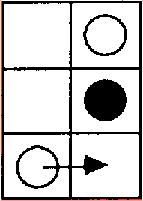
|
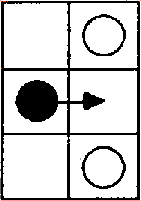
|
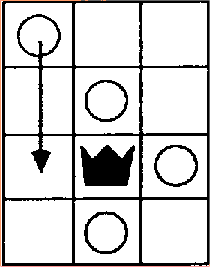
|
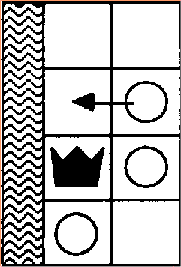
|
|
| Dark Taken | Dark Safe | King Captured | King Captured |
SPECIAL RULES - As the warrior pieces cannot enter the king's squares, the following two rules are necessary. The king is captured if he is adjacent to the centre square and surrounded by attacking pieces on the other three sides. A warrior piece blockading a corner square may be taken by pinning it against that square. A defending warrior protecting a king surrounded on the other sides by the enemy may be taken by pinning it against the king. The attacker also wins if his/her pieces are able to encircle all the king's pieces.
Due to the uneven nature of the sides and objectives, one player will have an advantage. Therefore a round will consist of two games, with players swapping sides. In the event of a tie, the player who lost the least number total of warrior pieces in both games will be the winner.
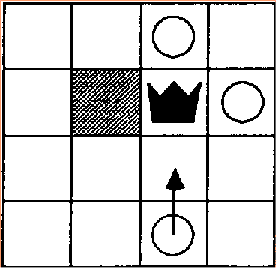
|
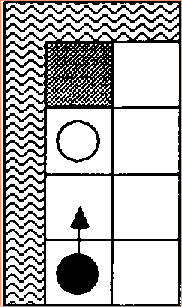
|
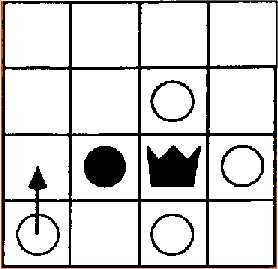
|
| King Captured | Light Taken | Dark Taken |
Nine Person's Morris (Mill)
Two players have nine pieces each, and enter them alternately one at a time on any vacant intersection on the board:

Nine Person's Morris (Mill)
The aim is to form a row of three along any line, and at the same time prevent the other player from doing so. When all the men have been played onto the board, they are moved by turns along the lines from one junction to the next. Every time a row of three is formed, the player may permanently remove one of his/her opponent's men. The winner is the player who reduces his opponent to only two men. There are also a number of alternative methods of play:
- if a players piece is trapped between two of his/her opponents, it is removed, until one player has only two pieces remaining.
- (quick play) the winner is the first to form a row of three.
Fox and Geese
The aim of the game for the geese is to trap the fox in a position from which it is impossible to move. The fox must deplete the geese to prevent this. Seventeen geese are arranged on the board as shown below, and the fox is positioned on any vacant place. The fox and geese can move in any direction along a line to the next contiguous point. The fox may also move diagonally, but may not jump this way. If the fox jumps over a goose and lands on an empty point beyond, the goose is killed and removed from the board. Two or more geese can be killed in one move by a series of short jumps by the fox. The geese can not jump the fox, but they try to crowd it into a corner and make it impossible for the fox to move. If the fox is immobilised, the player loses the game, but if the geese are so depleted they are unable to trap the fox the fox wins.
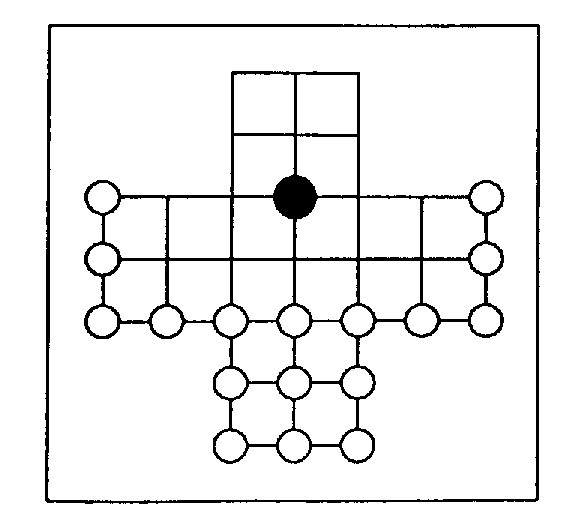
Starting positions for Fox and Geese





